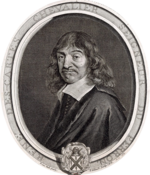La Géométrie
| Part of a series on |
| René Descartes |
|---|
 |
La Géométrie was published in 1637 as an appendix to Discours de la méthode (Discourse on Method), written by René Descartes. In the Discourse, he presents his method for obtaining clarity on any subject. La Géométrie and two other appendices also by Descartes, the Optics and the Meteorology, were published with the Discourse to give examples of the kinds of successes he had achieved following his method[1] (as well as, perhaps, considering the contemporary European social climate of intellectual competitiveness, to show off a bit to a wider audience).

The work was the first to propose the idea of uniting algebra and geometry into a single subject[2] and invented an algebraic geometry called analytic geometry, which involves reducing geometry to a form of arithmetic and algebra and translating geometric shapes into algebraic equations. For its time this was ground-breaking. It also contributed to the mathematical ideas of Leibniz and Newton and was thus important in the development of calculus.
Descartes is often credited with inventing the coordinate plane because he had the relevant concepts in his book.[3] The bulk of the book is occupied by Descartes's solution to "the problem of Pappus," in which, given a number of straight lines in certain positions, Descartes attempts to find the locus of points satisfying certain conditions in relation to the given lines. In solving this problem Descartes takes two line segments as unknown and designates them x and y. Known line segments are designated a, b, c, etc. The Cartesian coordinate plane was born of this convention.
Notes
- ^ René Descartes; Ian Maclean (2006). A discourse on the method of correctly conducting one's reason and seeking truth in the sciences. Oxford University Press. p. 1x. ISBN 0-19-282514-3.
- ^
René Descartes; Ian Maclean. cited work. p. 1xiii. ISBN 0-19-282514-3.
This short work marks the moment at which algebra and geometry ceased being separate.
- ^ A. D. Aleksandrov; Andréi Nikoláevich Kolmogórov; M. A. Lavrent'ev (1999). "§2: Descartes' two fundamental concepts". Mathematics, its content, methods, and meaning (Reprint of MIT Press 1963 ed.). Courier Dover Publications. pp. 184 ff. ISBN 0-486-40916-3.
References
- Smith David E.; Lantham M. L. (1954). The Geometry of René Descartes (Reprint of 1925 ed.). Courier Dover Publications. ISBN 0-486-60068-8.
- Carl B. Boyer (2004). History of Analytic Geometry (Reprint of 1956 ed.). Courier Dover Publications. ISBN 0-486-43832-5.
- Stephen W. Hawking (2005). "René Descartes". God created the integers: the mathematical breakthroughs that changed history. Running Press. pp. 285 ff. ISBN 0-7624-1922-9.
- M Serfati (2005). "Chapter 1: René Descartes, Géométrie, Latin edition (1649), French edition (1637)". In I. Grattan-Guinness; Roger Cooke (eds.). Landmark writings in Western mathematics 1640-1940. Elsevier. ISBN 0-444-50871-6.
- Emily Grosholz (1998). "Chapter 4: Cartesian method and the Geometry". In Georges J. D. Moyal (ed.). René Descartes: critical assessments. Routledge. ISBN 0-415-02358-0.
- Facsimile Wikisource (fr) : La Géométrie
External links
 Quotations related to La Géométrie at Wikiquote
Quotations related to La Géométrie at Wikiquote- Project Gutenberg copy of La Géométrie
- Bad OCR: Cornell University Library copy of La Géométrie
- Archive.org: The Geometry of Rene Descartes
